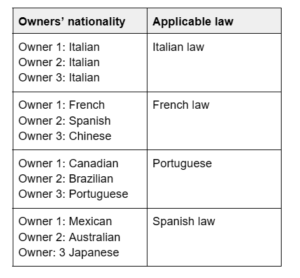Most trademarks are owned by one company or one person. However, it is not completely uncommon to find that a trademark registration is owned jointly by two or more parties. In fact, there is no limit to the number of owners that can co-own a trademark.
As with anything else in life, the more owners there are, the more likely it is that somewhere down the road disagreements will arise. These can include questions like whether to renew the registration or not, grant a license to a third party, sell the registration, use it as a collateral for finance arrangements, start infringement proceedings against a third party, and many others. The question that often arises is who decides.
Also, trademark laws of most countries do not have explicit rules on joint ownership. In most countries trademark laws merely state that a registered trademark can have multiple owners, but that’s as far as it usually goes. For national trademarks the laws of that country regulate joint ownership issues.
What law governs jointly owned EU trademarks?
The EU trademark regulation states that when considering EU trademarks as objects of property, they are treated like national trademarks. According to Article 19 of the EU trademark regulation:
“EU trade mark as an object of property shall be dealt with in its entirety, and for the whole area of the Union, as a national trade mark registered in the Member State in which, according to the Register… the proprietor has his seat or his domicile”.
This means, essentially, that an EU trademark owned by a French company will be considered for property purposes just like a national French trademark. If all owners are from the same country, the laws of that country apply to any disputes on how to govern the registration.
A completely different situation arises where there are multiple owners that are from different countries. It could be that an EU trademark is co-owned by a Portuguese and an Italian company. What law is applicable in this case: Portuguese or Italian?
The EU trademark regulation provides a clear yet somewhat arbitrary solution to this question: the laws of the country of the owner who is first mentioned in the trademark register apply. So, it is the order of the owners as they appear in the trademark register that decides which law governs the ownership questions. If the Portuguese company is mentioned in the register before the Italian company, Portuguese law will govern the co-ownership of that trademark (and vice versa).
This rule applies only to EU based owners. If none of the owners are from the EU countries, the Spanish law will be decisive because the EU trademark office is located in Spain (Alicante).
If there are owners from both EU and non-EU countries, the law of the first EU owner is applicable. The below chart illustrates the rule:
Why is this an important question?
It is important to know which law governs jointly owned trademarks, because different countries might have different rules regarding jointly owned property. It could be that, for example, according to the laws of one country unanimity of all owners is required when making decisions (for example, whether to license or renew a trademark), whereas in another country only majority decision is sufficient.
The importance of written agreements
In most countries it is possible to enter into agreements that govern how a property is used. Even where the owners come from the same country, it is possible that the default rules on joint ownership are not optimal, and the owners might wish to make their own rules on how to govern the property (trademarks, in this case). In most cases parties are free to agree between themselves on the governance of the property, and legislation kicks in only to provide default rules if nothing else has been agreed upon.
It is always recommended that before entering a joint ownership of trademarks (or any other property), the parties involved discuss and decide how to govern the ownership.
Here are some issues that the parties should agree on:
Ownership percentages. The percentage of ownership that each party holds in the joint trademark should be decided. This can be based on various factors such as financial or other contributions.
Decision-making. The parties should decide how decisions regarding the trademark will be made. It should also be specified which decisions require the consent of all owners and which can be made with the majority (and what that majority will be). There should also be a mechanism for resolving disputes or deadlocks.
Use and licensing. It should be decided who (if any) gets to use the mark and outline the rights and limitations of each party regarding the use and possible licensing of the trademark. Geographical scope of these rights should also be decided.
Financial obligations. The parties should decide how the costs and expenses related to the trademark will be shared among the co-owners. This includes application and registration fees, enforcement costs, marketing expenses, and any revenue sharing arrangements for licensing or royalties.
Brand protection and enforcement. The parties should define the responsibilities and obligations of each party in protecting and enforcing the trademark. For example, when to take legal action against infringements.
Termination or transfer. Define the circumstances under which the joint ownership arrangement may be terminated, such as if one party wants to sell their share to other owners or even third parties. Determine how the trademark ownership will be handled in such cases, including the right of first refusal for purchasing the departing party’s share.
Duration and Renewal. Specify the duration of the joint ownership arrangement and the process for renewing the trademark registration.
Conclusion
There are many instances where joint ownership of a trademark can be beneficial for all parties involved. After all, most companies are also jointly owned by various shareholders, so it should not be thought that joint ownership is inherently difficult or suspect. It often makes sense to pool resources and expertise.
However, it is important to realise that when property has more than one owner, the potential for conflicts increases greatly. Because of this, it is vital to plan and decide in great detail how the ownership is governed, and what are the rights and obligations of each owner. Also, it is important to know which laws are applicable to ownership questions if the owners come from different countries.
See related posts:
5 reasons why investors love intellectual property
We surveyed 400 companies – these are the five biggest trademark misunderstandings they have




